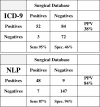Comparing methods for identifying pancreatic cancer patients using electronic data sources
- PMID: 21346976
- PMCID: PMC3041435
Comparing methods for identifying pancreatic cancer patients using electronic data sources
Abstract
We sought to determine the accuracy of two electronic methods of identifying pancreatic cancer in a cohort of pancreatic cyst patients, and to examine the reasons for identification failure. We used the International Classification of Diseases, 9(th) Edition (ICD-9) codes and natural language processing (NLP) technology to identify pancreatic cancer in these patients. We compared both methods to a human-validated gold-standard surgical database. Both ICD-9 codes and NLP technology achieved high sensitivity for identifying pancreatic cancer, but the ICD-9 code method achieved markedly lower specificity and PPV compared to the NLP method. The NLP method required only slightly greater expenditures of time and effort compared to the ICD-9 code method. We identified several variables influencing the accuracy of ICD-9 codes to identify cancer patients including: the identification algorithm, kind of cancer to be identified, presence of other conditions similar to cancer, and presence of conditions that are precancerous.
Figures
References
-
- Eichler AF, Lamont EB. Utility of administrative claims data for the study of brain metastases: a validation study. J Neurooncol. 2009 Dec;95(3):427–31. - PubMed
-
- Chang S, Long SR, Kutikova L, et al. Estimating the cost of cancer: results on the basis of claims data analyses for cancer patients diagnosed with seven types of cancer during 1999 to 2000. J Clin Oncol. 2004 Sep 1;22(17):3524–30. - PubMed
-
- Baldi I, Vicari P, Di Cuonzo D, et al. A high positive predictive value algorithm using hospital administrative data identified incident cancer cases. J Clin Epidemiol. 2008 Apr;61(4):373–9. - PubMed
-
- Freeman JL, Zhang D, Freeman DH, Goodwin JS. An approach to identifying incident breast cancer cases using Medicare claims data. J Clin Epidemiol. 2000 Jun;53(6):605–14. - PubMed
MeSH terms
LinkOut - more resources
Full Text Sources



